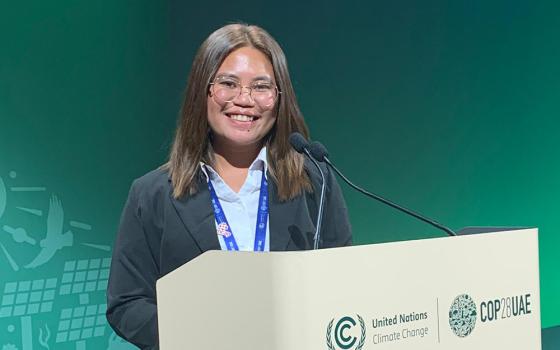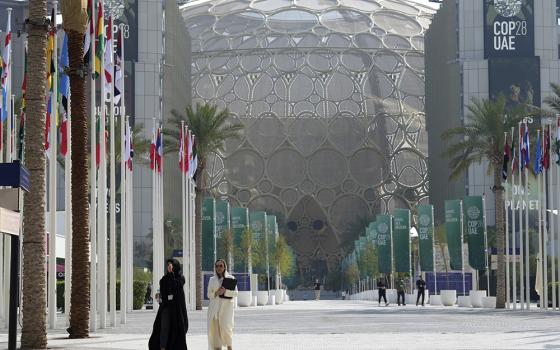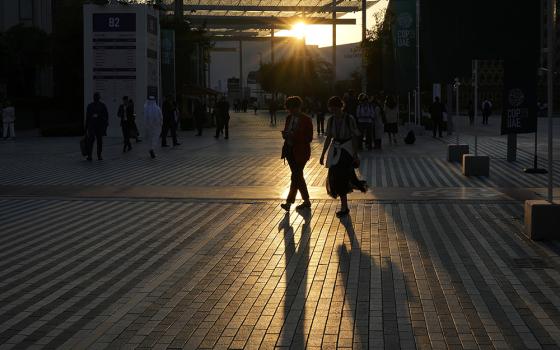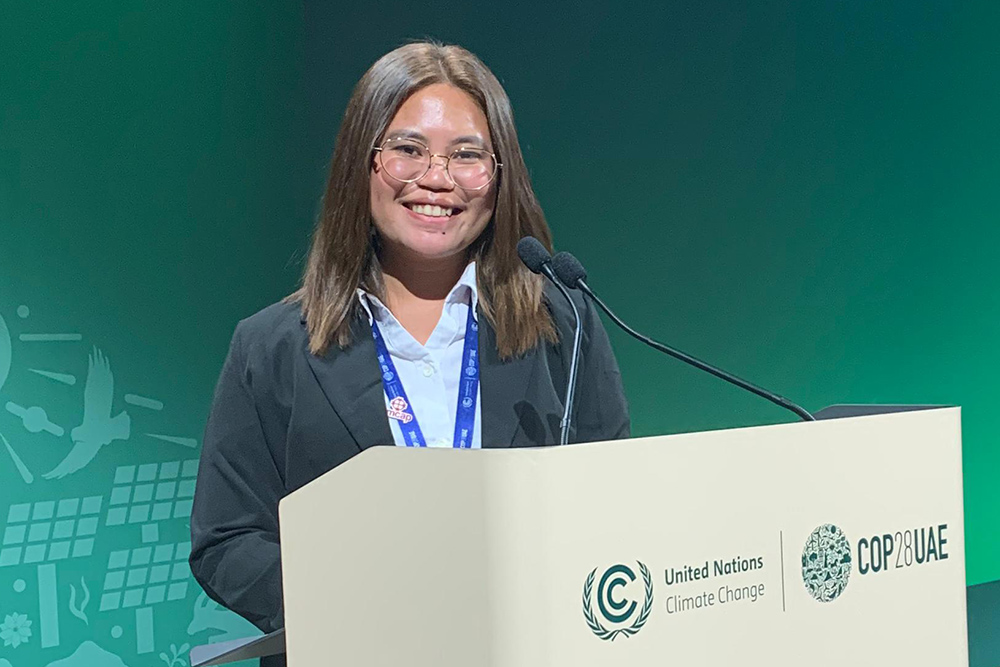
Precious Donna Gift Jayno, a 23-year-old civil engineer in Cebu City, Philippines, was part of the COP28 delegation of the International Federation of Catholic Parochial Youth Movements (FIMCAP), a network of Catholic youth organizations. (Courtesy of Precious Donna Gift Jayno)
The United Nations conference on climate change, COP28, was different from what I expected.
As an active Catholic youth, I entered COP28 mostly focused on the charism of my religious organization, Chiro Pilipinas, which aims to bring youth closer to Christ through interactive catechism. Environmental care and protection are part of our advocacies. So we partake in and initiate simple, straightforward events like clean-up drives, tree planting and growing, and proper waste segregation education.
However, COP28 was a whole new world. COP was a culture shock. It was complex and calculated. Numerous lengthy negotiations took place for two weeks. It was a battle full of technicalities and politics. Every word and detail of the proposal draft texts was scrutinized.
COP is a multilateral decision-making body where countries convene on actions to mitigate and adapt to climate change. The yearly endeavor, attended by national delegates and policy officers and civil society organizations, met for the first time in Berlin in March 1995.
COP28 in Dubai from Nov. 30 to Dec. 12, 2023, was regarded as a crucial moment for global action by the U.N. as it included the culmination of the first global stocktake, a reality check and a progress report on how far we've come on climate adaptation, mitigation and finance, and how much we need to attain in the next few years.
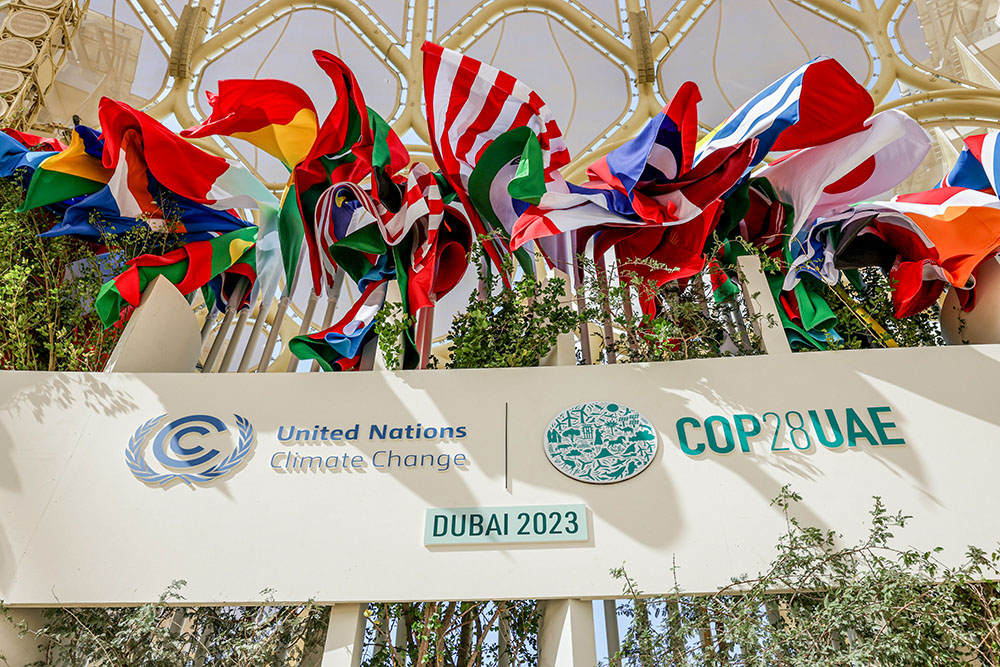
Flags can be seen inside the dome during COP28, the U.N. Climate Change Conference, at Expo City Dubai Nov. 30, 2023, in Dubai, United Arab Emirates. (CNS/Courtesy of UN Climate Change COP28/Christophe Viseux)
At COP, civil society organizations initiate events and interactions to advocate for their concerns. Civil society organizations coordinate seminars, talks, peaceful protests and bilateral meetings. If they're lucky, parties agree to present and push for the organization's stand. Getting parties to agree with civil society organizations is rigorous and tedious work, often with limited time for influence. Fortunately, that is not the case for Chiro Pilipinas.
In intergovernmental negotiation processes of the U.N. Framework Convention on Climate Change (UNFCCC), nongovernmental organizations like civil society groups are clustered into constituencies as participating stockholders called "observers." There are nine constituencies:
- Business and industry;
- Environmental organizations;
- Farmers;
- Indigenous peoples;
- Local government and municipal authorities;
- Research and independent organizations;
- Trade unions;
- Women and gender;
- Youth.
Because there is no specific constituency assigned for faith-based organizations, groups like Chiro Philipinas can register in other constituencies based on their advocacies or ministries. Since the umbrella organization of Chiro Pilipinas — Fédération Internationale des Mouvements Catholiques d'Action Paroissiale, or International Federation of Catholic Parochial Youth Movements (FIMCAP) — is a Catholic organization centered on youth, their membership is to the youth constituency.
Our delegation was widely connected to faith-based organizations, youth organizations, women-centered organizations and to the Holy See, which represents Vatican City.
As an intercontinent delegation, we also had access to different parties and continental federations from our individual countries and continents. Although I was a first-timer, I was fortunate to be supported by a widely connected organization, which provided me with the full experience of COP. But I still had my fair share of challenges.
COP28 was divided into two zones: the blue zone and the green zone. The blue zone, the formal conference and negotiation space, was managed by the U.N.; while the green zone, the informal setting for global communities and civil societies, was managed by the host country, the United Arab Emirates (UAE).
In the first week, I followed and attended informal meetings and coordination meetings, scrutinized and reviewed draft texts, created proposals to change phrases or words that would benefit our campaign, and convinced parties to get on board with our campaign to phase out fossil fuels.
In the second week, I organized actions like peaceful protests and attended more coordination meetings to further appeal to the parties. This describes a typical COP experience except for two important milestones: It was during COP28 that the first Faith Pavilion was established, and the creation of a Catholic actors coalition was realized.
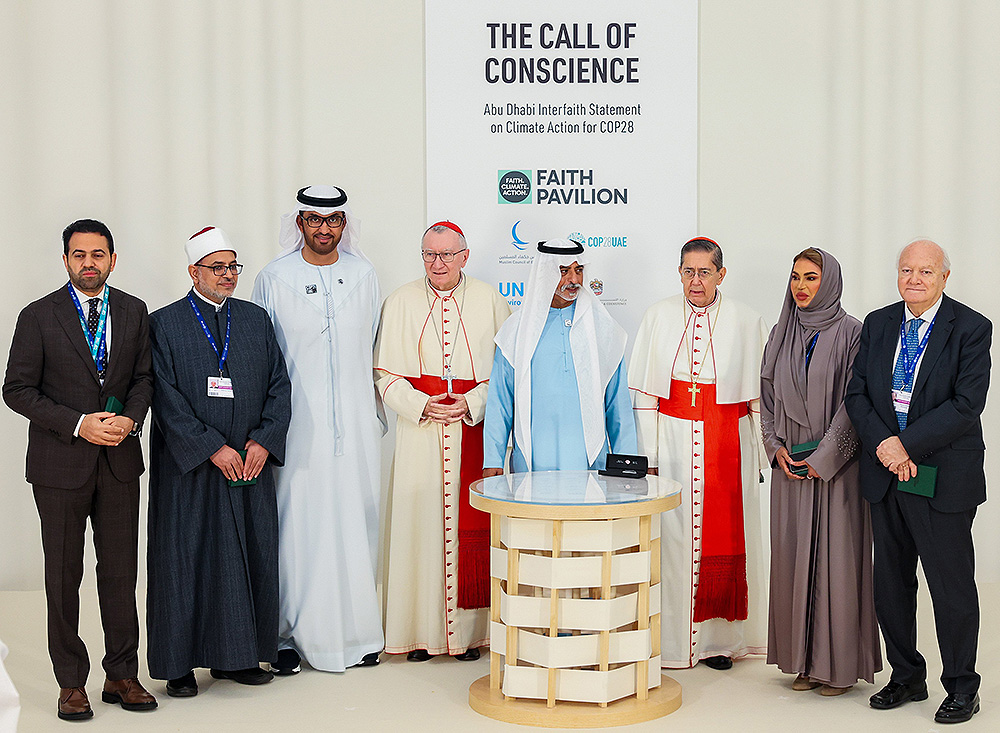
Cardinal Pietro Parolin (fourth from left), Vatican secretary of state, poses for a group photo next to Sultan Ahmed al-Jaber (third from left), the president-designate of COP28; Sheikh Nahyan bin Mubarak Al Nahyan (center), the UAE minister of tolerance and coexistence; and Cardinal Miguel Ángel Ayuso (third from right), prefect of the Dicastery for Interreligious Dialogue, along with other representatives at the inauguration of the Faith Pavilion during COP28, in Dubai, United Arab Emirates, Dec. 3, 2023. (CNS/Courtesy of U.N. Climate Change COP28/Christopher Pike)
Since it was the first COP with a Faith Pavilion, faith-based organizations had a more significant presence at the conference. The pavilion became a fort for said organizations to establish their footing in this kind of undertaking, commune with other organizations despite differences, and celebrate in unity for taking charge in climate action.
It was both a milestone and a symbol of recognition that faith-based organizations are one with the world in fighting against climate change.
The institution of a Catholic actors coalition also carved an emblem of a more refined and more systematic coordination of all Catholic organizations across the world. Although the coalition is still in the works as of this writing, a bright future for the Catholic Church's participation in climate action is in sight, as this will consolidate and generate a unified stance that the Holy See and other parties can consider more clearly and efficiently.
It was precisely through coordination meetings with the Holy See that Catholic organizations saw the need to form a coalition. Indeed, the presence of the Holy See had ignited the concord among the organizations.
Apart from this, the Catholic Church's participation in COP — through civil society organizations headed by people in ministry or by priests and archbishops themselves — is duly seen as an obligation. Climate change is a question of morality and righteousness, a conflict rising from abandoning and abusing God's creation and hence, contradicting God's first and greatest commandment — to love God with all our heart, soul and mind (Matthew 22:37). It is appropriate, and right, that the church partake in such assemblies.
However, it was evident that there were limitations on how much the Holy See and other parties could do in matters of phasing out fossil fuels and other critical issues of climate justice and action. Such a call is what many civil society organizations were aiming for from the start of COP28, but were unable to achieve by the end. It was disappointing and tragic, but also understandable.
Advertisement
A fast, fair and complete fossil fuel phaseout is the ideal action to achieve net-zero carbon emissions by 2050, but the grave reality lies in the situations of the least-developed countries and countries whose economies are dependent on fossil fuel investments and subsidies.
COP28 was not able to mark the end of fossil fuels, but instead it marked the "beginning of the end" for the fossil fuel era as referred to by U.N. Climate Change Executive Secretary Simon Stiell. COP28 apparently laid out the "ground for a swift, just and equitable transition, underpinned by deep emissions cuts and scaled-up finance."
But now we must see how committed states are to ending fossil fuel use, as well as to climate finance, the loss and damage fund, climate adaptation finance, and other commitments. It could take years, but we need to make good on the promises. For now, we can hope for the best and be more vigilant at future COPs.
As a young Catholic environment advocate, COP28 showed me the complicated reality of efficiently and sustainably fighting climate change. It is both a challenge and a responsibility to continue the fight, both at the forefront and in the background. But most importantly, COP confirmed my obligation as a Catholic to continuously care for and protect the environment always and in all ways possible.




